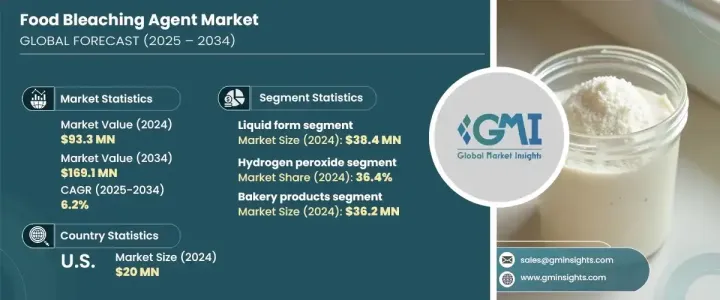PUBLISHER: Global Market Insights Inc. | PRODUCT CODE: 1684592

PUBLISHER: Global Market Insights Inc. | PRODUCT CODE: 1684592
Food Bleaching Agent Market Opportunity, Growth Drivers, Industry Trend Analysis, and Forecast 2025 - 2034
The Global Food Bleaching Agent Market, with a valuation of USD 93.3 million in 2024, is projected to grow at a CAGR of 6.2% from 2025 to 2034. These agents, available in both chemical and natural forms, play a vital role in the food processing industry by enhancing the visual appeal of food products through color lightening or removal. Their ability to improve the quality and appearance of processed foods has made them indispensable in the competitive food industry, where presentation is key to consumer appeal.

A growing consumer preference for convenient, ready-to-eat food options is fueling the demand for food bleaching agents. As processed and packaged foods become household staples, manufacturers are increasingly focusing on ensuring these products look visually appealing to attract buyers. Food bleaching agents effectively deliver uniformity and brightness to products like flour, sugar, oils, and other processed goods, enhancing their market potential. The shift toward cleaner labels and natural ingredients has further driven innovation in this market, allowing companies to align with evolving consumer expectations.
| Market Scope | |
|---|---|
| Start Year | 2024 |
| Forecast Year | 2025-2034 |
| Start Value | $93.3 Million |
| Forecast Value | $169.1 Million |
| CAGR | 6.2% |
Segmented by form, the food bleaching agent market encompasses both liquid and powder variations. Liquid bleaching agents, valued at USD 38.4 million in 2024, are preferred by manufacturers for their ease of application and consistent results during food processing. Their versatility extends to beverages, dairy products, and other liquid-based food items, making them a top choice across diverse applications. These agents enable efficient bleaching while seamlessly integrating into production processes, providing an edge in the competitive market.
When classified by type, hydrogen peroxide emerged as the leading food bleaching agent in 2024, capturing a 36.4% share. Widely recognized for its dual functionality as a bleaching and oxidizing agent, hydrogen peroxide significantly enhances the quality and appearance of processed foods. Its applications span the bakery, dairy, and beverage sectors, where it not only lightens products but also helps inhibit microbial growth, extending shelf life. The adaptability and effectiveness of hydrogen peroxide position it as a cornerstone in the food processing industry.
In the United States, the food bleaching agent market reached USD 20 million in 2024, driven by a strong demand for processed foods like bakery goods, confectionery, and dairy items. The country's robust food processing sector and consumer preference for visually appealing products have created a thriving market for bleaching agents. Furthermore, the rising interest in clean-label products is encouraging manufacturers to adopt natural bleaching solutions, catering to health-conscious consumers who prioritize transparency in food production.
Table of Contents
Chapter 1 Methodology & Scope
- 1.1 Market scope & definition
- 1.2 Base estimates & calculations
- 1.3 Forecast calculation
- 1.4 Data sources
- 1.4.1 Primary
- 1.4.2 Secondary
- 1.4.2.1 Paid sources
- 1.4.2.2 Public sources
Chapter 2 Executive Summary
- 2.1 Industry synopsis, 2021-2034
Chapter 3 Industry Insights
- 3.1 Industry ecosystem analysis
- 3.1.1 Factor affecting the value chain
- 3.1.2 Profit margin analysis
- 3.1.3 Disruptions
- 3.1.4 Future outlook
- 3.1.5 Manufacturers
- 3.1.6 Distributors
- 3.2 Supplier landscape
- 3.3 Profit margin analysis
- 3.4 Key news & initiatives
- 3.5 Regulatory landscape
- 3.6 Impact forces
- 3.6.1 Growth drivers
- 3.6.1.1 Rising demand for processed and packaged food products requiring visual enhancement
- 3.6.1.2 Increasing adoption of bleaching agents in bakery and confectionery applications
- 3.6.1.3 Technological advancements in natural and synthetic food bleaching agents
- 3.6.2 Industry pitfalls & challenges
- 3.6.2.1 Growing consumer preference for clean-label and natural ingredients
- 3.6.2.2 Potential health concerns related to synthetic bleaching agents affecting market growth
- 3.6.1 Growth drivers
- 3.7 Growth potential analysis
- 3.8 Porter's analysis
- 3.9 PESTEL analysis
Chapter 4 Competitive Landscape, 2024
- 4.1 Introduction
- 4.2 Company market share analysis
- 4.3 Competitive positioning matrix
- 4.4 Strategic outlook matrix
Chapter 5 Market Size and Forecast, By Form, 2021-2034 (USD Million, Kilo Tons)
- 5.1 Key trends
- 5.2 Liquid
- 5.3 Powder
Chapter 6 Market Size and Forecast, By Type, 2021-2034 (USD Million, Kilo Tons)
- 6.1 Key trends
- 6.2 Azodicarbonamide
- 6.3 Hydrogen peroxide
- 6.4 Ascorbic acid
- 6.5 Acetone peroxide
- 6.6 Chlorine dioxide
- 6.7 Others
Chapter 7 Market Size and Forecast, By Application, 2021-2034 (USD Million, Kilo Tons)
- 7.1 Key trends
- 7.2 Bakery products
- 7.3 Flour
- 7.4 Cheese
- 7.5 Others
Chapter 8 Market Size and Forecast, By Region, 2021-2034 (USD Million, Kilo Tons)
- 8.1 Key trends
- 8.2 North America
- 8.2.1 U.S.
- 8.2.2 Canada
- 8.3 Europe
- 8.3.1 UK
- 8.3.2 Germany
- 8.3.3 France
- 8.3.4 Italy
- 8.3.5 Spain
- 8.3.6 Russia
- 8.4 Asia Pacific
- 8.4.1 China
- 8.4.2 India
- 8.4.3 Japan
- 8.4.4 South Korea
- 8.4.5 Australia
- 8.5 Latin America
- 8.5.1 Brazil
- 8.5.2 Mexico
- 8.6 MEA
- 8.6.1 South Africa
- 8.6.2 Saudi Arabia
- 8.6.3 UAE
Chapter 9 Company Profiles
- 9.1 American Elements
- 9.2 Arkema
- 9.3 DSM
- 9.4 Evonik Industries
- 9.5 Gujarat Alkalies and Chemicals
- 9.6 Ineos
- 9.7 Kemira
- 9.8 Loba Chemie
- 9.9 Nouryon
- 9.10 Solvay
- 9.11 United Initiators




